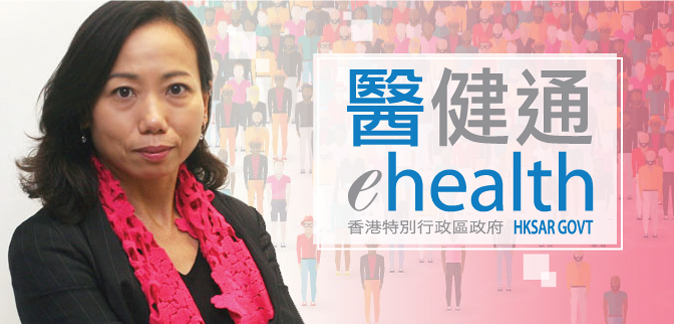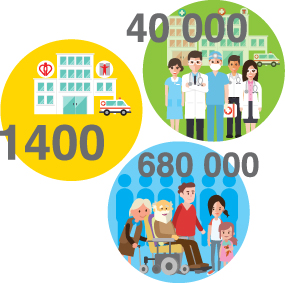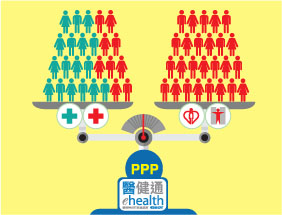 |
|
At the second anniversary of the launch of the Electronic Health Record Sharing System (eHRSS), Ms Ida
Lee, Commissioner for the Electronic Health Record, gave a review and outlook on eHRSS’ development. |
Ms Ida Lee,
Commissioner for the Electronic Health Record
|
|
|
| |
|
The Government-led, territory-wide eHRSS was launched in March 2016. As at end-January 2018, more than 680 000 patients and over 1400 private healthcare providers (HCPs), the Hospital Authority (HA), the Department of Health (DH) and all of the 12 local private hospitals, have already registered with the system. Over 40 000 accounts have been created for healthcare professionals under these HCPs.
“Our initial estimation was that registration would pick up
progressively. Such an overwhelming response over a
short period of time is indeed encouraging and beyond
our expectation, especially when participation is entirely
voluntary,” said Ms Lee.
Ms Lee attributed the successful implementation of eHRSS to
the practical and user-friendly design of the system, the
experience accumulated by HA in developing its Clinical
Management System (CMS) and adopting electronic health records
(eHR), the system security measures in place and the legal
framework specially devised for data and privacy protection.
“The community is becoming more aware of the benefits of the
system, how information technology (IT) can facilitate the
provision of quality medical services, and the importance of data
sharing to the continuity of healthcare,” she remarked.
|
 |
|
The Government-led, territory-wide eHRSS was launched in March 2016 with encouraging response over the past 2 years
|
|
|
|
| |
|
A Healthcare IT Solution with Increasing Recognition
|
| |
|
eHRSS has been gaining not only acceptance among the local public and healthcare practitioners, but also recognition in the information and communications technology (ICT) sector. In 2017, it won the Best Business Solution (Application) Gold Award in the Hong Kong ICT Awards 2017, as well as the Government and Public Sector Category Winner Award in the Asia Pacific ICT Alliance Awards 2017. In February 2018, eHRSS once again received international recognition, winning the Innovative eHealth Solutions Award of the World Information Technology and Services Alliance Global ICT Excellence Awards 2018.
|
| |
“The technical design is a significant attribute,” said Ms
Lee. “Yet all the more important, eHRSS provides the
essential infrastructure to support the Government’s
healthcare reform, allowing us to make use of an IT
solution to drive and implement various health
initiatives.”
“For example, the launch of Public-Private Partnership
(PPP) programmes can help balance the demand for
medical services in the public and private sectors, a
situation which is unique in Hong Kong where the
public healthcare system is heavily relied upon.
eHRSS, being the infrastructure for record sharing
among public and private sectors in these
programmes, provides a robust foundation for
implementing PPP initiatives.”
|
 |
|
eHRSS provides a foundation for PPP
programmes to help balance the demand
for medical services in the public and
private sectors
|
|
|
|
| |
 |
|
The Government embarked on the
Stage Two Development of eHRSS in
July 2017, aiming to bring further
benefits to patients and the
healthcare sector
|
|
|
“As our population ages, eHRSS helps meet the medical needs of
our society by facilitating the delivery of cross-disciplinary and
sustainable healthcare, as well as fostering public-private
collaboration.”
eHRSS Stage Two Development and Challenges
In July 2017, the Government embarked on the Stage Two
Development of eHRSS with the aim to bring further benefits to
patients and the healthcare sector.
Major areas of work include broadening the scope of sharable
data to cover radiological images and Chinese medicine (CM),
providing features to enhance patients’ choice over the scope of
data sharing, and establishing a Patient Portal to facilitate
patients’ access to some pre-defined data in the system.
|
|
| |
| Outlining the work of Stage Two, Ms Lee said the IT technicalities
involved in sharing radiological images are particularly
challenging. “We need to take into consideration the file size, the
types of records to be uploaded, and how to share and display
the records,” she explained. |
| |
|
As to CM, while the sector welcomes the idea of data sharing, the challenge is in standardising the clinical
terminology and promoting computerisation of health records, said Ms Lee, adding that the sharing of CM
data is likely to be launched in the later phase of Stage Two.
|
| |
|
“Terminology standardisation in CM is more complex, covering not only the diagnoses and names of
Chinese herbal medicines, but also the processing methods, medicinal parts and names of origins. It also
covers specific treatment methods associated with acupuncture and tui-na,” she said.
|
| |
|
To encourage computerisation among CM practitioners, the Government will develop a CMS On-ramp application and CMS adaptation modules for CM, and is planning to
run pilots to test out CM data sharing, Ms Lee added.
|
| |
|
On the subject of enhancing patients’ choice, Ms Lee said a consultancy study has just commenced to explore the provision of sharing restriction features and functions to be included in the Patient Portal, and to examine related issues including data privacy, system security and authentication.
|
| |
|
“We need to consider what are useful for patients and how the new features and functionalities can help
patients manage their health. At the same time, we need to strike a balance between complexity in design
and ease of use. If it is too complex, it will deter patients from participating in eHRSS.”
|
| |
|
Ms Lee estimated that the Patient Portal would be implemented by phases, with basic functions to be
offered first.
|
| |
|
Driving Further eHRSS Participation
|
| |
|
Regarding efforts to promote eHRSS participation, Ms Lee said the Government, apart from stepping up
publicity, has introduced a series of enhancement measures to facilitate participation.
|
| |
|
“For instance, the scope of online submission has recently been expanded to enable applications made
by some substitute decision makers like parents. Patients can now also authorise representatives to
submit eHRSS applications. In parallel, mobile teams will continue to visit different community venues to
help the public register with eHRSS.”
|
| |
|
“With more patients joining the system, we believe it will become a driver for HCPs’ participation,” she
said.
|
| |
|
“On the other hand, the launch of new PPP initiatives can be incentives for HCPs to join eHRSS, giving
them the chance to experience and appreciate the benefits of eHR sharing.”
|
| |
|
In her final remark, Ms Lee said, “I truly believe eHRSS is helpful and have registered myself. Looking
forward, there is a great deal to work on for eHRSS’ further development. I am thankful to colleagues for
their dedication and look to them for their continued support.”
|
| |
|
| |
|

